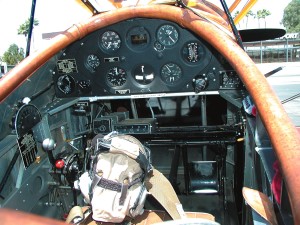By Britton Bloom
Some say the sense of adventure has gone out of aviation in the 21st century world of pressurized cabins and high-tech instruments that allow a plane to virtually fly itself.
Others, however, spend their lives keeping that sense of adventure alive. Don Mayes, founder and pilot of Gypsy Flyers, is keeping the sense of excitement alive on the runway of the Scottsdale Airport.
Mayes is a barnstormer, selling rides in his open cockpit biplane just as the old-time pilots did after World War I, giving his passengers a chance to feel the wind in their faces as they soar above the Valley.
“This is the kind of flying that’s fun,” Mayes said. “I want to bring back a nostalgic part of flying that’s being lost.”
“It gives people an opportunity to go back in history,” his wife and partner, Angel, said.
Barnstorming is a unique facet of aviation history that began when military pilots were demobilized after World War I, and discovered that they could not leave their love of flying back in the barracks.
Without a war, the military did not need an air service anymore, so the Army sold off its surplus Curtiss “Jennies” for a song, and pilots snapped them up. But there was no aviation industry in 1920 America, so these fliers had to make their own living in the sky.
Many pilots began flying across the country, landing in open farm fields or at state fairs to sell rides to farmers and small town residents so they could buy enough fuel to get to the next stop.
“Those gypsy fliers lived like carnival folks,” Mayes said. “They would land in a field and charge people a couple bucks or a meal for a ride, flying by the seat of their pants. They made their own makeshift repairs with anything at hand to keep flying. In those days there were no regulations or rules, no government ‘Daddy’ looking over your shoulder. They did what they had to just to keep flying.”
Mayes’ own plane is a 1940 N3N biplane, the only aircraft designed and built by the U.S. Navy as a trainer for its cadets. The Navy began building the N3N in 1938 out of surplus dirigible parts in order to save money, which kept the cost down to $25,000 each. These last biplanes used by the U.S. military were painted a bright yellow, which earned them the nickname “Yellow Peril.”
When Mayes decided he wanted to found Gypsy Flyers, a pilot friend told him about a N3N biplane in Missouri. Mayes went to see it, and bought the plane on the spot, then flew it home in true barnstormer fashion, selling rides along the way and stopping at every small airport along the way to look for spare parts.
“It took a week to get back, but I had a good time,” Mayes said.
The N3N represents flying at its most basic level, without instruments or high-tech gear to help the pilot.

The bare bones cockpit of the Gypsy Flyers biplane offers few of the conveniences of modern aviation.
“Fifty years ago, this airplane was ‘the’ thing,” Mayes said. “Many people still remember them. When I was a kid, biplanes were very common at airports, and that is the era we are losing. Pilots now don’t know how to fly without a Global Positioning System or autopilot. They’re just lost when it comes to basic flying.”
Mayes’ love of adventure extends much farther back than the three years he has been involved with Gypsy Flyers.
A native of Oregon, Mayes has been involved in aviation all his life, most of it flying the slurry tankers used to dump fire retardant chemicals on forest fires.
In many ways, the life of a slurry tanker pilot is similar to the old barnstormers, Mayes said. Like the gypsy barnstormers, tanker pilots are constantly on the move and fly by the seats of their pants, relying on the “feel” of the plane and their own experience rather than instruments, he added.
In the course of his career as a tanker pilot, Mayes fought forest fires ranging from Alaska’s Aleutian Islands to Monterrey, Mexico.
“One year I was on the road for 160 days, never more than three days in any one town,” Mayes remembered. “You go wherever the fires take you.”
But a footloose lifestyle can wear thin, even for an adventurer like Mayes.
“After 28 years of bouncing around, I decided it was time to do something with my life,” Mayes said.
So he settled in Alaska for a time, and flew as a bush pilot, ranging above the Arctic Circle to provide a link with civilization for towns that are inaccessible by any other method of transportation.
“In a village of maybe 100 people, their only way in or out is by plane,” Mayes said. “The vastness of that country is unbelievable.”
And getting to those remote places has its own beauty and adventure in the land where the sun never sets in the summer.
“I’ve flown in low over every national park there,” Mayes said. “You get to see a place like Glacier Park in a way most people don’t.”
For Don Mayes, the act of flying in itself is a lifelong love, whether he is flying as a firefighter in a slurry tanker or a bush pilot in Alaska or a barnstormer in the Southwest desert; that sense of excitement at facing a new challenge is very much the same spirit that animated the early pioneers of aviation.
For more information, call Don and Angel Mayes at Gypsy Flyers at (480) 419-5736.












